Family Pomacentridae: Suzumedai-ka
Abudefduf sexfasciatus (Lacepède): Rokusen-suzumedai
FUMT-P 4127, 4288; 12 specimens; spring and summer; 26-55 mm SL; 3 empty.

A. sexfasciatus, which usually hovered in large aggregations over the reefs, fed on filamentous algae and small planktonic animals. Allen (1975a) also reported A. scxfcisciatus (as A. coelestinus) feeding in large aggregations on zooplankton and algae.
Abudefduf vaigiensis (Quoy et Gaimard): Oyabitcha
FUMT-P 4128; 7 specimens; summer; 30-101 mm SL.
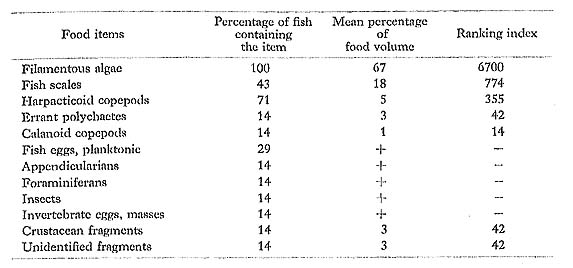
A. vaigiensis often hovers in small or large schools over the reefs. It had taken mostly filamentous algae and small planktonic animals, which are much the same prey as taken by the same species (as A. saxatilis) in the Red Sea (Fishelson, 1970) and the Florida Keys (Emery, 1973). The algal diet of this species remains controversial, however. In describing the feeding behavior of A, vaigiensis, Fishelson (1970) noted that it feeds on "floating" algae, whereas Emery (1973) reported that it feeds mainly on "benthonic" algae. Unfortunately we lack sufficient observations of the feeding behavior needed to resolve this issue.
On the basis of a single specimen in the Marshall Islands, Hiatt and Strasburg (1960) classified this species (as A, saxatilis) as a browsing herbivore, even though they found many small crustaceans among the algae in its diet.
Amblyglyphidodon curacao (Bloch): Kurakao-suzumedai
FUMT-P 4129, 4289; 27 specimens; spring and summer; 45-80 mm SL; 1 empty.
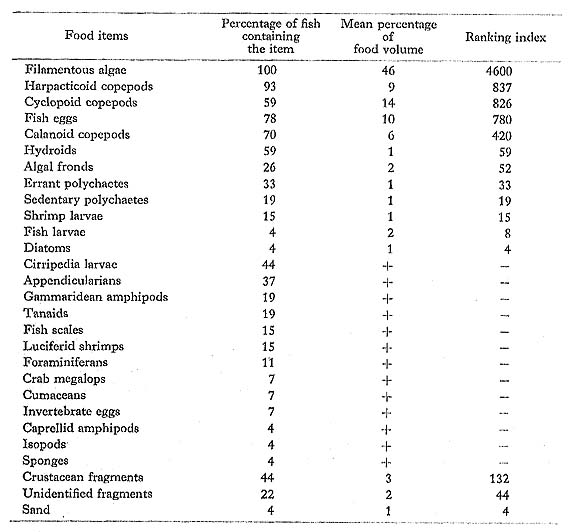
A. curacao had taken a variety of organisms, especially filamentous algae, planktonic crustaceans, and fish eggs. Allen (1975a) found larval crabs, shrimps, fish eggs, and algae in the single specimen that he examined in Palau. In addition, Hobson and Chess (1978) reported large amounts of algal fragments (mean percentage of food volume: 64%), as well as copepods (23%) and fish eggs (5%), in the five specimens of A. curacao collected from weak-current areas in Eniwetok Atoll. They considered this species to be primarily a carnivore, but with the capacity to utilize algae when zooplankton is scarce.
According to this evidence, we classify A. curacao as an omnivore rather than as a carnivore.
Amphiprion clarkii (Bcnnett): Kumanomi
FUMT-P 4130, 4290; 8 specimens; spring and summer; 29-75 mm SL.
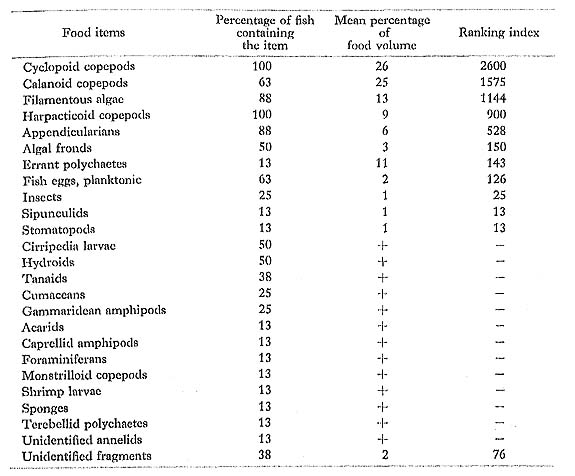
In feeding mostly on planktonic crustaceans and algae, the diet of A. clarkii at Minatogawa was essentially the same as that of four congeners at Eniwetok-A. chrysopterus, A. melanopus, A. perideraion, and A. tricinctus (Allen, 1975b).
Amphiprion frenatus Brevoort: Hama-kumanomi
FUMT-P 4131, 4291; 7 specimens; spring and summer; 26-76 mm SL.
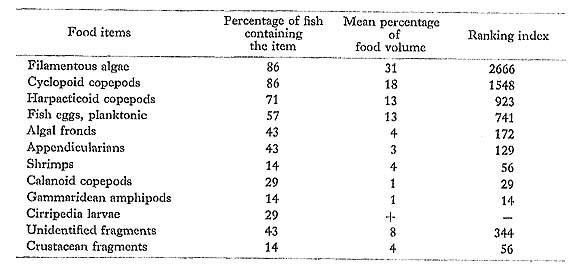
Like A. clarkii, this species had fed on algae and zooplankters, mostly copepods.
Amphiprion ocellaris Cuvier: Kakure-kumanomi
FUMT-P 4132, 4292; 10 specimens; spring and summer; 31-49 mm SL.
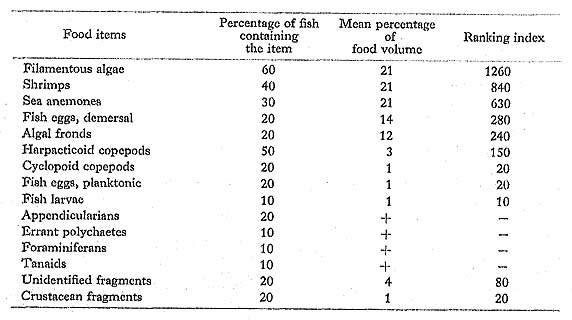
In addition to algae and small crustaceans, this species had consumed many seaanemone tentacles.
Allen (1975b) reported that parents of Amphiprion species during incubation regularly remove their dead eggs from the nest and ingest them. Therefore, the demersal fish eggs among its stomach contents are presumed to be the removed dead eggs.
Cheiloprion labiatus (Day): Atsukuchi-suzumcdai
FUMT-P 4133, 4293; 26 specimens; spring and summer; 30-59 mm SL; 2 empty.
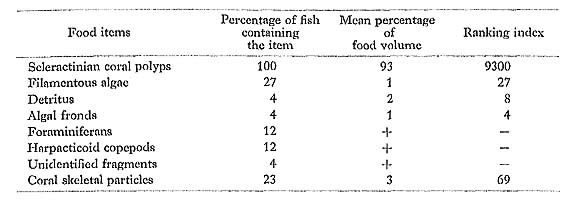
The major diet of C. labiatus was acleractinian corals (probably Acropora), both polyps and mucus. We observed it repeatedly picking or scraping the surfaces of living staghorn Acropora with its lips, which arc greatly thickened and curled back over the snout and chin. Similar feeding behavior and habits have been noted by Allen (1975a) and Masuda et al. (1980).
Chromis atripectoralis Welander ct Schultz: Aoba-suzumedai
FUMT-P 4134, 4294; 16 specimens; spring and summer; 50-72 mm SL; 18 empty.
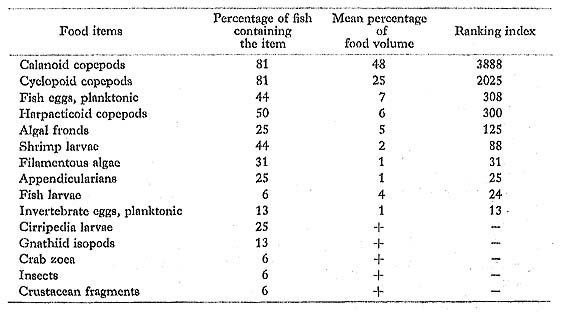
Although many specimens of this species were empty, those with food had taken planktonic crustaceans, fish eggs, and algae. Hiatt and Strasburg (1960) found mostly small zooplankters, especially copepods, mysids, and shrimp nauplii, in the diet of this species from the Marshall Islands, and suspected it to be carnivorous.
Chromis caerulea (Cuvier): Deba-suzumedai
FUMT-P 4295; 30 specimens; spring; 46-64 mm SL; 3 empty.
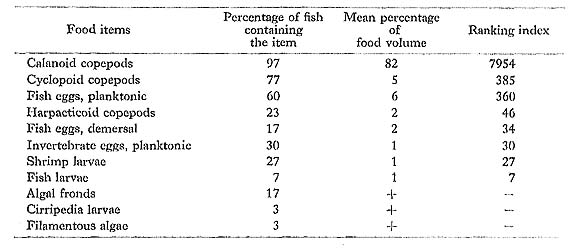
FUMT-P 4135; 29 specimens; summer; 38-58 mm SL; 5 empty.
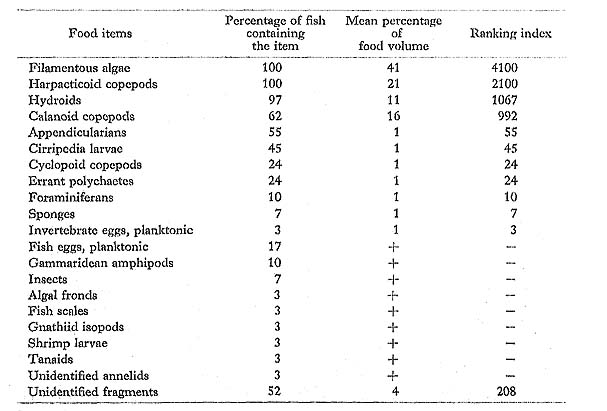
The food habits of C. caerulea differed between spring and summer: It took mostly copepods in spring, but filamentous algae and various small planktonic invertebrates in summer. These limited food data indicate that C. caerulea at Minatogawa is a zooplankton feeder in spring but an omnivore in summer.
Gerber and Marshall (1974) noted that C. caerulea from Eniwetok Atoll during "December to February" contained both algal fragments and zooplankters, whereas Hobson and Chess (1978) found only zooplankters, especially copepods, in the same species collected from the same locality in "April." Also, Hiatt and Strasburg (1960) noted that C. caerulea from Arno Atoll, Marshall Islands, in "summer" is a carnivore, feeding primarily on planktonic crustaceans and fish eggs. These food data suggest that it probably shows seasonal changes in its food habits.
Chrysiptera cyanea (Quoy et Gaimard): Ruri-suzumedai FUMT-P 4136, 4296; 27 specimens; spring and summer; 30-52 mm SL; 1 empty.
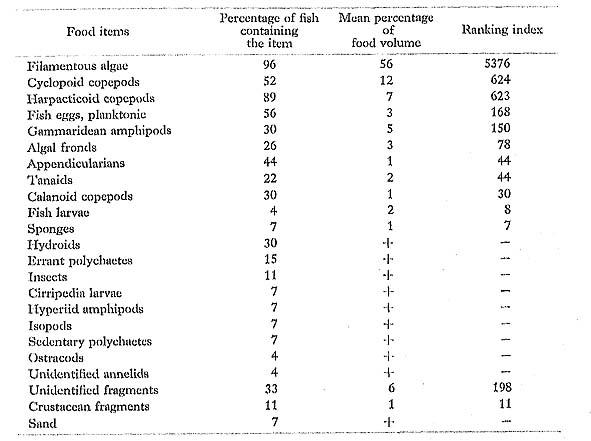
C. cyanea had taken mostly algae and small planktonic crustaceans, as did the same species elsewhere examined by Allen (1975a: reported as Glyphidodontops cyaneus).
Chrysiptera glauca (Cuvier): Nezu-suzumedai
FUMT-P 4137; 6 specimens; summer; 60-69 mm SL.

C. glauca commonly occurred on the shallow flattened rocky reefs, where it fed on algae, detritus, and small benthonic invertebrates. Hiatt and Strasburg (1960) found chiefly algae, benthonic crustaceans, and small fishes in the diet of this species (as Abudefduf glaucus) which they examined in the Marshall Islands.
Chrysiptera leucopoma (Lesson): Miyako-ldsen-suzumedai
FUMT-P 4138, 4297; 9 specimens; spring and summer; 44-65 mm SL.
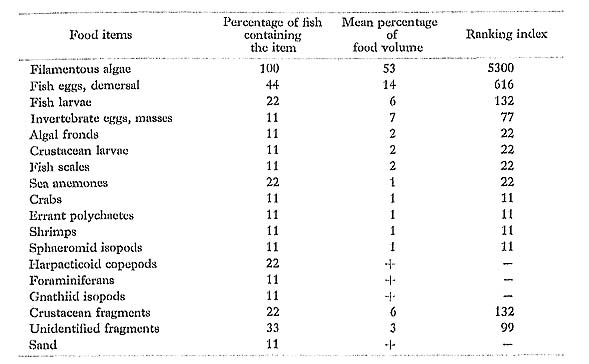
Like C. glauca, this species usually inhabited shallow flattened rocky reefs, where it took algae, eggs, and small invertebrates. In the Marshall Islands, Hiatt and Strasburg (1960) reported that "it [C. leucopoma: as Abudefduf leucopomus] appears to be a true omnivorc, taking not only fine algal filaments scraped from coral rubble but also feeding in mid-water on small planktonic crustaceans, pteropods, and amaller fishes."
Chrysiptera rex (Snyder): Remon-suzumedai
FUMT-P 4139, 4298; 14 specimens; spring and summer; 34-54 mm SL.
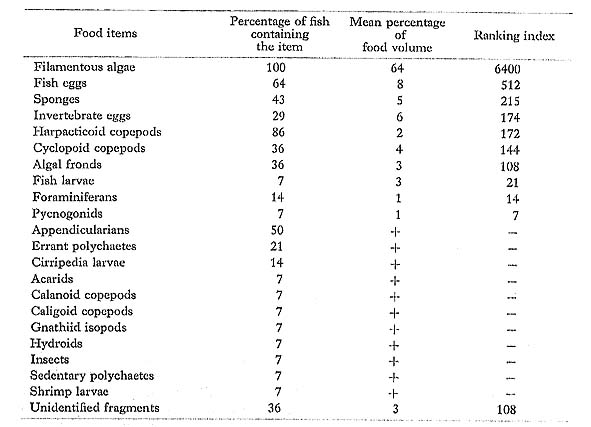
C. rex usually occurs along the outer reef wall or in the surge channels. Like C. leucopoma, it had fed mostly on algae, eggs, and small invertebrates, suggesting that it is strictly omnivorous.
Chrysiptera unimaculatus (Cuvier): Ichimon-suzumedai
FUMT-P 4140.
Two specimens (51 and 57 mm SL) collected from the rocky reefs in summer contained filamentous algae (mean percentage of food volume: 85%), algal fronds (10%), crabs (5%), and harpacticoid copepods (+) in the stomachs.
Allen (1975a) reported that it feeds mostly on benthonic algae.
Dascyllus aruanus (Linnaeus): Misuji-ryukyu-suzumedai
FUMT-P 4141, 4299; 50 specimens; spring and summer; 25-49 mm SL; 2 empty.
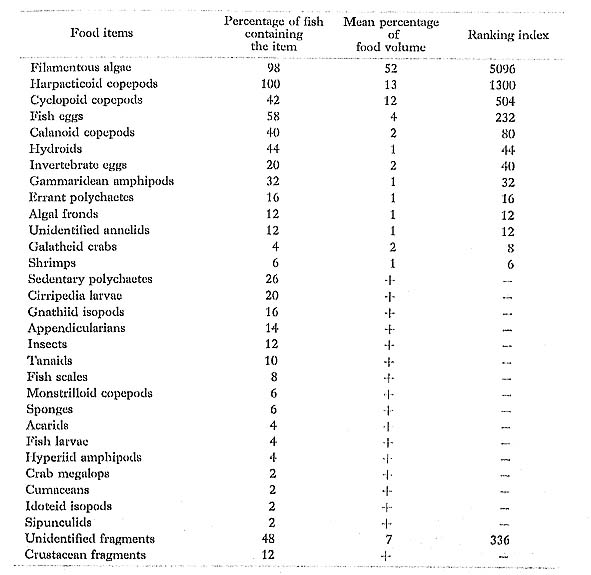
D. aruanus had fed on algae and various small animals, suggesting that it is strictly omnivorous. Similar findings have been obtained in the Marshall Islands by Hiatt and Strasburg (1960) and Gerber and Marshall (1974).
Dascyllus melanurus Bleeker: Yosuji-ryukyu-suzumedai
FUMT-P 4142.
A single specimen (44 mm SL) of D. melanurus was collected from a reef consisting mostly of staghorn Acropora in summer. Its stomach was full of filamentous algae, along with a few harpacticoid copepods and invertebrate eggs (less than 1% of the content) that may have been taken incidentally.
Allen (1975a) and Randall and Allen (1977) described that the diet of D. melanurus consists of a variety of plankton, including larval shrimps and crabs, algae, ostracods, amphipods, pelagic tunicates, copepods, and fish eggs.
Dischistodus prosopotaenia (Bleeker): Kiseboshi-suzumedai
FUMT-P 4143; 2 specimens; summer; 66 and 120 mm SL.
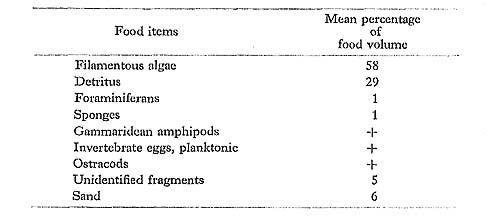
Most of the prey of D.prosopotaenia were filamentous algae and detritus.
Paraglyphidodon melas (Cuvier): Kuro-suzumedai
FUMT-P 4145, 4301; 14 specimens; spring and summer; 36-129 mm SL.
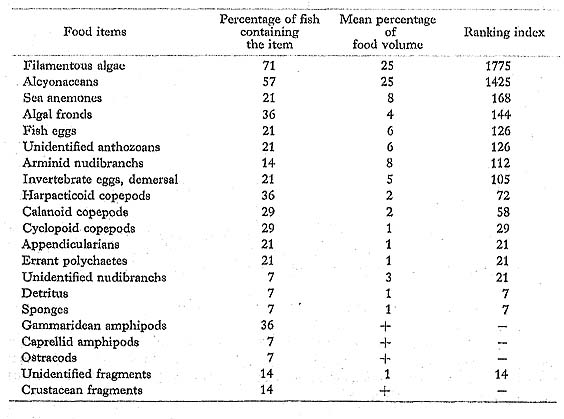
P. melas, which frequently occurred around soft corals (alcyonaceans) on Minatogawa reefs, fed on both algae and a variety of invertebrates, especially polyps of alcyonaceans.
Plectroglyphidodon dickii (Lienard): Ishigaki-suzumedai
FUMT-P 4146, 4302; 12 specimens; spring and summer; 45-63 mm SL; 3 empty.
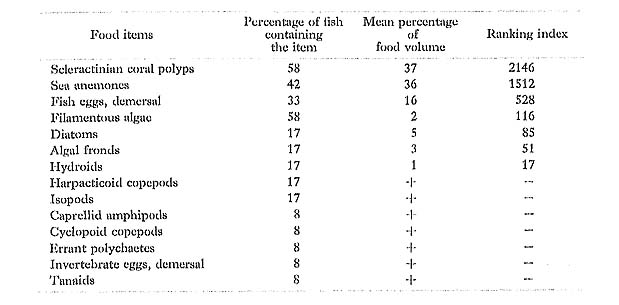
Although the major item in the diet of P. dickii at Minatogawa was anthozoans, Hiatt and Strasburg (1960) found the diet of this species (as Abudefduf dicki) in the Marshall Islands to be filamentous algae and fish fragments. They commented: "The browsing herbivorous habits of this species predominate, but it is an opportunistic species which will take smaller fiah and doubtless swimming invertebrates which venture near it." On the other hand, Allen (1975a) reported only that P. dickii feeds mostly on benthonic algae. These two results contrast with ours at Minatogawa, where it takes very small amounts of algae.
Plectroglyphidodon johnstonianus Fowler et Ball: Rurime-iahigaki-suzumedai
FUMT-P 4147, 4303; 8 specimens; spring and summer; 52-60 mm SL; 4 empty.

In feeding mostly on scleractinian corals-both polyps and mucus with no skeletal material-the diet of P. johnstonianus at Minatogawa was essentially the same as that of the same species in Hawaii (Hobson, 1974). Because it lives closely associated with Acropora corals, presumably these are the corals upon which it feeds. But in Hawaii, where corals of this genus are rare, it feeds on other genera (Hobson, personal communication).
Plectroglyphidodon lacrymatus (Quoy et Gaimard): Rurihoshi-suzumedai
FUMT-P 4148, 4304; 12 specimens; spring and summer; 33-66 mm SL; 1 empty.
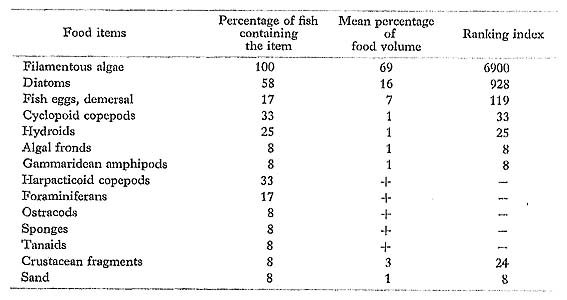
We frequently observed that P. lacrymatus occurs among the branches of Acropora corals and cultures luxuriant filamentous algae on the dead portions of the branches in its home range. Thus ,our data confirms the observation made by Yamamoto (1979) in the Ryukyu Islands. It had fed mostly on filamentous algae and diatoms, but also took some fish eggs and small invertebrates.
Hiatt and Strasburg (1960) noted that P. lacrymatus (as Abudefduf lacrymatus) in the Marshall Islands is a herbivore browsing on fine filamentous algae, although copepods, foraminiferans, gastropods, and fish eggs are picked up inadvertently with algae. According to our stomach content analysis, however, we classify P. lacrymatus at Minatogawa as an omnivore (see Chapter IV), although it cultures the filamentous algae in its home range.
Plectroglyphidodon leucozonus (Bleeker): Hakusen-suzumedai
FUMT-P 4149; 3 specimens; summer; 51-58 mm SL.
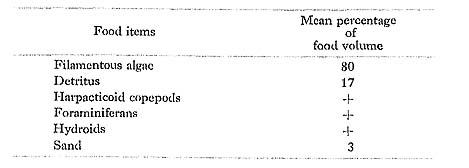
P. lencozonus, which usually occurred on shallow flattened rocky reefs, fed on filamentous algae and detritus, as noted by Allen (1975a).
Pomacentrus amboinensis Bleeker: Nise-nettai-suzumedai
FUMT-P 4150, 4305; 18 specimens; spring and summer; 39-69 mm SL.
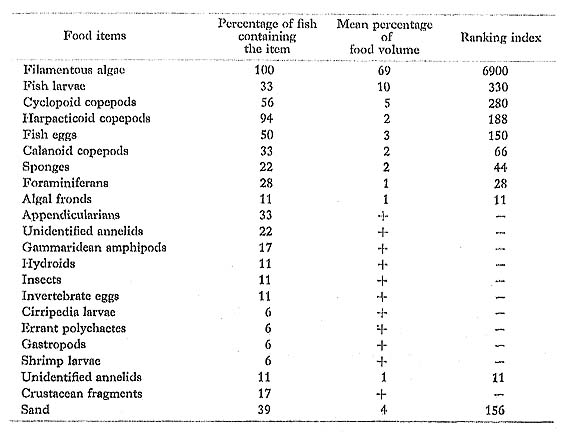
P. amboinensis had eaten both algae and small planktonic animals, as did the same species elsewhere examined by Allen (1975a).
Pomacentrus bankanensis Bleeker: Megane-suzumedai
FUMT-P 4310; 2 specimens; spring; 47 and 50 mm SL; 1 empty.

Most of the prey of P. bankanensis were algae. Allen (1975a) reported that it feeds mainly on algae but also takes copepods, isopoda, and pelagic tunicates.
Pomacentrus flavicauda Whitley: Ojiro-suzumedai
FUMT-P 4151, 4306; 32 specimens; spring and summer; 42-62 mm SL; 1 empty.
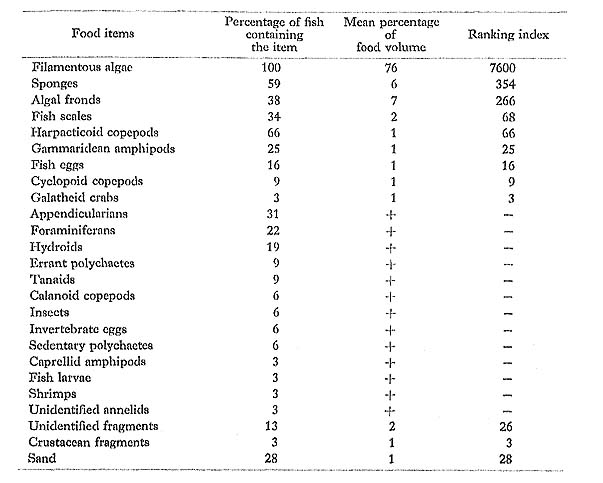
The major prey of. P. flavicauda were algae, but it also took various small invertebratea,
Alien (1975a) reported that it feeds primarily on algae, as noted by Low (1971), who examined both feeding behavior and stomach contents of this species from Heron Island, Great Barrier Reef. Similarly, on the basis of the ten specimens at Kuchierabu Island, Japan, Gushima (1981) classified P. flavicauda as a grazing herbivore, even though he found many small animals such as amphipods and copepods (mean. percentage of food volume: 8%) among the algae in their diets. Despite its herbivorous habit in other locations, however, we label P. flavicauda at Minatogawa as an omnivore (see Chapter IV), because some amounts of small invertebrates were taken with algae.
Pomacentrus littoralis Cuvier: Minami-iso-suzumedai
FUMT-P 4152, 4307; 18 specimens; spring and summer; 51-70 mm SL; 1 empty.
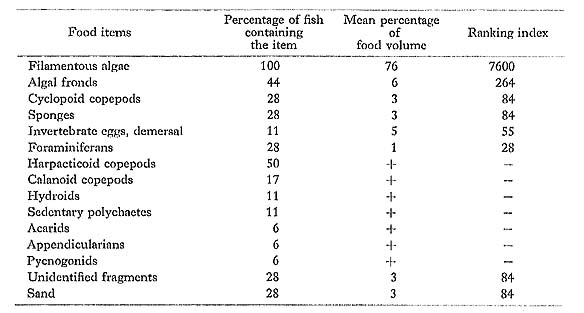
Like P. flavicauda, the major item in the diet of P. littoralis was algae, but it also took small invertebrates and eggs. Thus, we classify this species at Minatogawa as an omnivore rather than as a herbivore.
Pomacentrus moluccensis Bleeker: Nettai-suzumedai
FUMT-P 4153, 4308; 30 specimens; spring and summer; 32-52 mm SL; 2 empty.
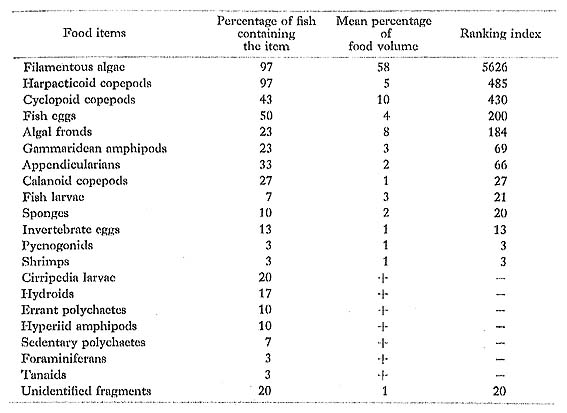
In addition to algae, P. molucccnsis had consumed many small invertebrates, especially crustaceans. Allen (1975a) reported only that it feeds mainly on bcnthonic algae.
Pomacentrus nagasakiensis (Tanaka): Nagasaki-suzumedai
FUMT-P 4309.
A single specimen (39 mm SL) was collected from the upper outer reef slope at a depth of about seven meters in spring. Its stomach contained algal fronds (percentage of food volume: 40%), filamentous algae (30%), appendicularians (20%), calanoid copepods (5%), and cyclopoid copepods (5%).
Pomachromis richardsoni (Snyder): Okinawa-suzumedai
FUMT-P 4154; 14 specimens; summer; 39-47 mm SL.
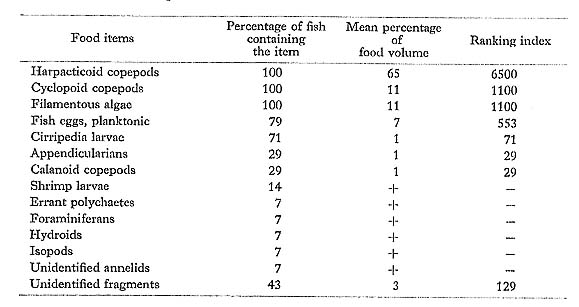
P. richardsoni, which frequently occurred in small to large midwater feeding aggregations above the outer reef slope, fed mostly on small planktonic crustaceans and eggs, along with filamentous algae.
Stegastes nigricans (Lacepède): Kuro-sora-suzumedai
FUMT-P 4144, 4300; 16 specimens; spring and summer; 65-90 mm SL; 2 empty.
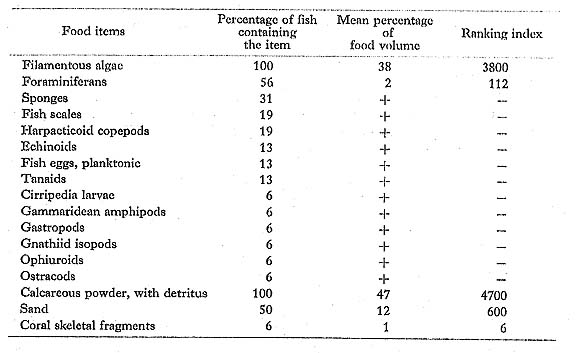
S. nigricans usually occurs among the branches of Acropora corals where fine filamentous algae grow heavily on the dead portions of the branches. It intensely defends these locations against foraging herbivorous fishes such as scarids and acanthurids (Yamamoto, 1979; Sano, personal observation).
Filamentous algae and detritus mixed with calcareous powder were the major items in the gut of S. nigricans at Minatogawa. Probably the various small invertebrates in the gut were taken incidentally when the fish grazed its major prey.
Hiatt and Strasburg (1960) noted that S. nigricans (as Pomacentrus nigricans) in the Marshall Islands is almost exclusively a grazing herbivore taking fine filamentous algae. But they also suggested that it can be omnivorous at times because of the fact that some specimens had fish fragments remaining in the stomach. We found no evidence that S. nigricans at Minatogawa is omnivorous.



























